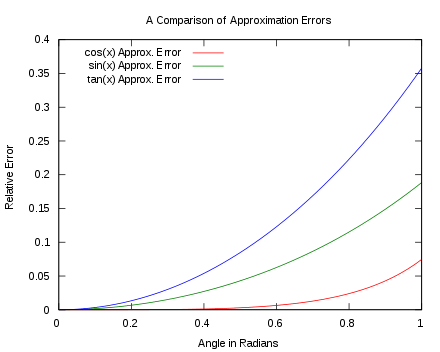Paraxial approximation
In geometric optics, the paraxial approximation is a small-angle approximation used in Gaussian optics and ray tracing of light through an optical system (such as a lens).[1][2]

A paraxial ray is a ray which makes a small angle (θ) to the optical axis of the system, and lies close to the axis throughout the system.[1] Generally, this allows three important approximations (for θ in radians) for calculation of the ray's path, namely:[1]
The paraxial approximation is used in Gaussian optics and first-order ray tracing.[1] Ray transfer matrix analysis is one method that uses the approximation.
In some cases, the second-order approximation is also called "paraxial". The approximations above for sine and tangent do not change for the "second-order" paraxial approximation (the second term in their Taylor series expansion is zero), while for cosine the second order approximation is
The second-order approximation is accurate within 0.5% for angles under about 10°, but its inaccuracy grows significantly for larger angles.[3]
For larger angles it is often necessary to distinguish between meridional rays, which lie in a plane containing the optical axis, and sagittal rays, which do not.
References
- Greivenkamp, John E. (2004). Field Guide to Geometrical Optics. SPIE Field Guides. 1. SPIE. pp. 19–20. ISBN 0-8194-5294-7.
- Weisstein, Eric W. (2007). "Paraxial Approximation". ScienceWorld. Wolfram Research. Retrieved 15 January 2014.
- "Paraxial approximation error plot". Wolfram Alpha. Wolfram Research. Retrieved 26 August 2014.
External links
- Paraxial Approximation and the Mirror by David Schurig, The Wolfram Demonstrations Project.